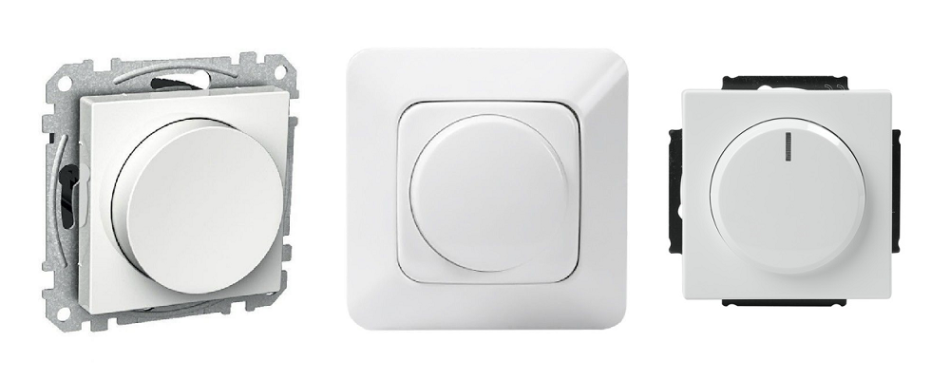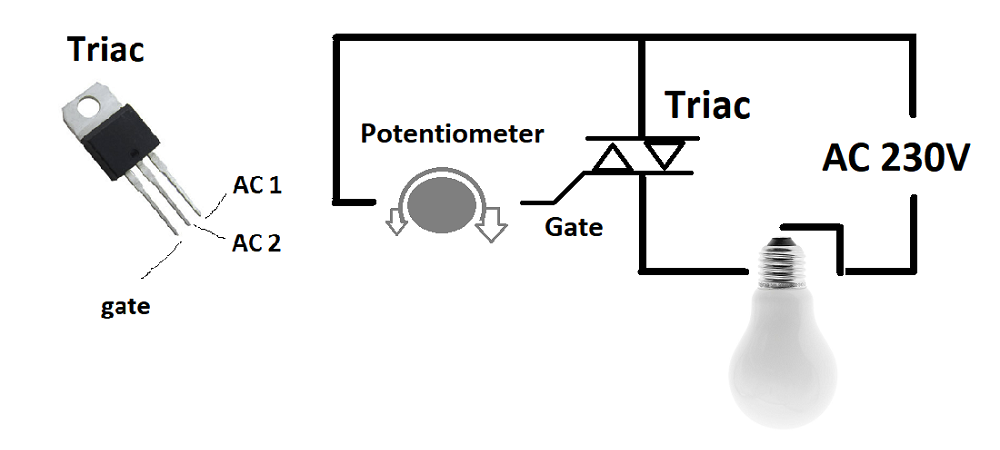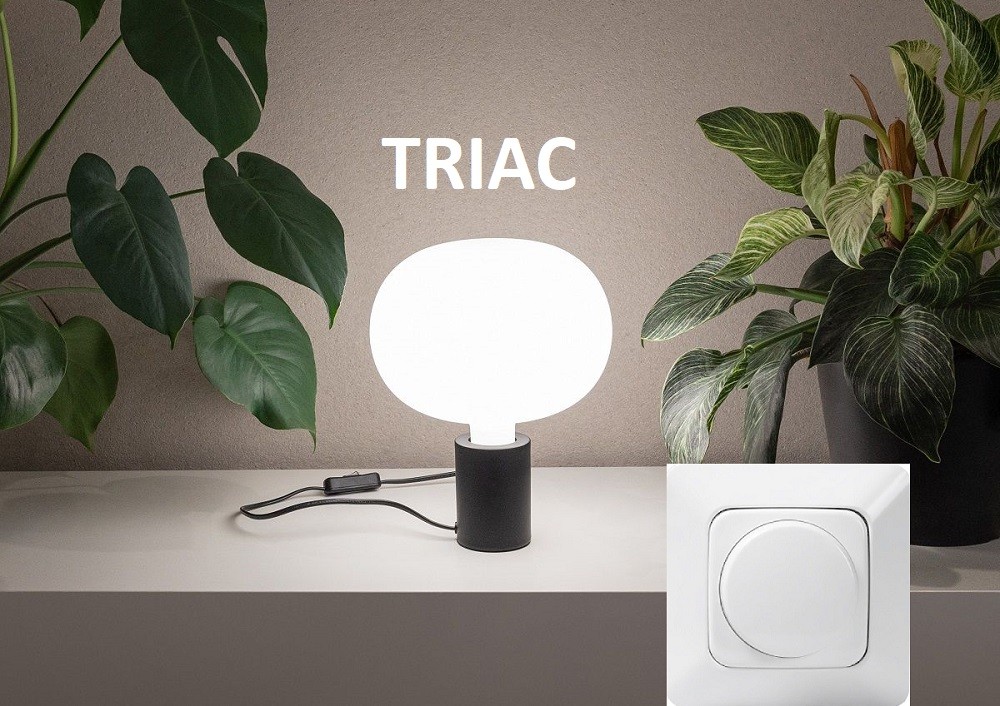[vc_row][vc_column][vc_column_text]TRIAC dimming, also known as phase-cut/Leading edge/trailing edge dimming, is a widely used method of controlling the intensity of LED lights. It works by adjusting the phase angle at which the AC voltage is applied to the LED luminaire or transformer. This method is compatible with most LED lights and dimmable LED transformers, making it a popular choice for both new and old applications. This article is part of the Led Dimming Technology article
TRIAC dimming as an option
One of the main advantages of TRIAC dimming is its compatibility with traditional incandescent dimmer switches. This allows easy replacement of incandescent lamps with LED lights, as existing dimmer switches can be used without additional wiring or rewiring. In addition, TRIAC dimming is relatively inexpensive and easy to install.
However, there are also some limitations to TRIAC dimming. One of the main problems is that it can cause flicker in some cases, especially when used with certain types of LED lights or dimmable LED transformers. Flicker can be caused by the phase separation method used in TRIAC dimming, which can cause uneven or pulsating light output. In addition, TRIAC dimming can in some cases also cause changes in the colour of the light, as the phase angle at which the AC voltage is applied can affect the colour temperature of the LED lights.

To mitigate these problems, it is important to use high quality LED lights and dimmable LED transformers specifically designed for use with TRIAC dimming. It is also recommended to use a good quality TRIAC dimmer to ensure a smooth and flicker-free dimming.
Another important aspect of TRIAC dimming is choosing the right dimmer switch. Not all TRIAC dimmer switches are compatible with all types of LED lights and dimmable LED drivers. It is important to check the compatibility of the dimmer switch with the LED light or LED driver to be dimmed. Some dimmer switches may not be compatible with certain types of LED lights or dimmable LED drivers, which can cause flicker or other problems.
In addition, TRIAC dimming can work best with dimmable LED transformers with built-in active correction. This allows the dimmable LED transformer to actively correct for phase angle changes caused by the TRIAC dimmer switch, resulting in a more stable and flicker-free dimmer.
Despite its limitations, TRIAC dimming remains a popular choice among lighting professionals and homeowners alike because it is compatible with traditional dimmer switches and because it is relatively inexpensive and easy to install. When properly selected, LED luminaires and dimmable LED transformers using a high quality TRIAC dimmer switch can provide a smooth and flicker-free dimming experience.
Triac dimming history
For the masses, Triac dimming was born in 1958 when Lutron company founder Joel Spira got his hands on a new type of SRC controller, the TRIAC circuit. It was significantly smaller (the size of a breadbox!) than the old dimming components and in 1959 the “Capri” filament dimmer was born.

What is TRIAC?
TRIAC = Triode for Alternating Current. TRIAC is an electronic component with three connectors that can conduct current in either direction when switched on. This configuration is equivalent to two SCRs with ports connected in reverse parallel and connected together.
TRIAC is activated by a gate signal that is analogous to the silicon carbide (SCR) signal. The port signal allows the device to draw power in either direction. TRIAC was originally developed to facilitate the management of AC power.

How does TRIAC dimming work?
TRIAC dimming is a way to control how bright the light can be. It works by sending small electrical pulses to the lamp. Pulses control the amount of light, so if the pulses are small, the light is less bright. If the pulses are larger, the light is brighter.
A TRIAC dimmer is a switch that controls how much electricity flows into the light. The dimmer consists of three parts: a knob, a switch and a TRIAC circuit. The knob is used to change the brightness of the light, and the switch is used to turn the light on and off. TRIAC controls how much electricity is emitted into the light. When the knob is turned, TRIAC changes the electrical wave. This in turn changes how much electricity enters the light, making it brighter or dimmer.
TRIAC dimmers are just like momentary switches. They are used to control the amount of current that passes through the LED light. When the device is switched on, it starts to move electrons through its internal components.
Triac dimming for dummies like me
Let’s imagine you have a lamp in your room and you want to control how bright it gets. A Triac dimming switch is a device that allows you to do just that!
Think of the lamp as a balloon that is filled with air. The more air you add to the balloon, the brighter the lamp gets. The Triac dimming switch is like a valve that controls the amount of air that goes into the balloon.
Now, instead of air, the lamp is powered by electricity. And instead of a valve, the Triac dimming switch uses something called a Triac. A Triac is like a switch that turns the electricity on and off very quickly. By doing this, it controls the amount of electricity that goes to the lamp, which makes it brighter or dimmer.
So, when you turn the Triac dimming switch, it’s like opening and closing the valve to control how much electricity goes to the lamp. And that’s how a Triac dimming switch works!
Front and back edge dimming
There are two main types of LED dimming: leading edge and trailing edge. The two methods differ in the way they control the voltage of the LED lights, which can affect the operation of the dimmer.
Front edge dimming
Leading edge dimming, also known as leading edge, is a dimming technique that reduces the voltage of LED lights by cutting off the leading edge of the AC waveform. This is done by switching the circuit on and off at a high frequency, which reduces the overall voltage of the LED lights. This method is commonly used in older dimmers and is not recommended for use with LED lights, as it can cause flicker and other problems. Most of these dimmers are made for larger (over 40W) loads, so you can’t dim at all using a small load.
Rear edge dimming
Trailing edge dimming, also known as trailing edge, is a dimming technique that reduces the voltage of LED lights by cutting off the trailing edge of the AC waveform. This is done by switching the circuit on and off at a low frequency, which reduces the overall voltage of the LED lights. This method is commonly used in newer dimmer switches, and is recommended for use with LED lights because it allows smooth, flicker-free dimming even at lower loads.
So leading edge dimming is an older method that is not recommended for use with LED lights because it tends to cause flicker and other problems. Dimming at the trailing edge, on the other hand, is a newer method that is recommended for use with LED lights because it allows for a smooth and flicker-free dimming. It is important to check the compatibility of the dimmer switch with the LED light or LED driver to be dimmed and to use a good quality dimmer switch designed for use with LED lights.
Here is a video about TRIAC dimming (in English):[/vc_column_text][/vc_column][/vc_row][vc_row][vc_column][vc_video link=”https://www.youtube.com/embed/5-wPkFv6eJE”][/vc_column][/vc_row][vc_row][vc_column][vc_column_text]
The pros and cons of TRIAC dimming
Pros:
- Compatibility: the TRIAC dimmer is compatible with most LED lights and dimmable LED transformers, making it a popular choice for lighting. This allows easy replacement of incandescent lamps with LED lights, as existing dimmer switches can be used without additional wiring or rewiring.
- Cost-effective: the TRIAC dimmer is relatively inexpensive and easy to install.
- Widely available: TRIAC dimmers are widely available and easy to find, making it a convenient option for most lighting projects.
Cons:
- Flicker: TRIAC dimming may cause flicker in some cases, especially when used with certain types of LED lights or dimmable LED transformers. This flicker can be caused by the phase separation method used in TRIAC dimming, which can cause uneven or pulsating light output.
- Colour change: in some cases, TRIAC dimming can also cause a colour shift of the light, as the phase angle at which the AC voltage is applied can affect the colour temperature of the LED lights.
- Compatibility issues: not all TRIAC dimmer switches are compatible with all types of LED lights and dimmable LED transformers. It is important to check the compatibility of the dimmer switch with the specific LED light or dimmable LED transformer to be used.
[/vc_column_text][vc_column_text]Frequently asked questions about TRIAC dimming[/vc_column_text][vc_toggle title=”What is TRIAC dimming?”]What is TRIAC dimming? TRIAC dimming is a type of dimming method that uses a semiconductor component called TRIAC (Triode for Alternating Current) to control the voltage of the lights. This method is commonly used in traditional incandescent dimmer switches and is compatible with most types of LED light.[/vc_toggle][vc_toggle title=”How does TRIAC dimming work?”]TRIAC dimming works by switching the circuit on and off at a high frequency, reducing the overall voltage of the lights. The TRIAC device is used to control the timing of the switch, which determines the level of dimming.[/vc_toggle][vc_toggle title=”What are the benefits of TRIAC dimming?”]TRIAC dimming is a cost-effective and widely available dimming method that is compatible with most LED light types. It also allows for smooth and flicker-free dimming, which improves the overall visual experience.[/vc_toggle][vc_toggle title=”What are the limitations of TRIAC dimming?”]TRIAC dimming can cause problems such as flicker and colour shifts in some LED lights and may not be compatible with certain types of dimmable LED transformers. In addition, it may not offer the same precision and control as other dimming methods.[/vc_toggle][vc_toggle title=”How do I know if my LED lights are compatible with TRIAC dimming?”]Refer to the manufacturer’s specifications for your LED luminaire or dimmable LED driver to determine compatibility with TRIAC dimming. It is also important to use a good quality dimmer designed for use with LED lights.[/vc_toggle][vc_toggle title=”How do I install a TRIAC dimmer switch?”]In most cases, it is sufficient to remove the normal switch and install the dimmer in the same way between the two wires. Check the manufacturer’s instructions for your specific dimmer switch, as installation may vary depending on the type and model. A qualified electrician is recommended for the installation of electrical equipment.[/vc_toggle][vc_toggle title=”Can I use a traditional incandescent dimmer with LED lights?”]Some traditional incandescent dimmers may be compatible with LED lights, but it is important to check the manufacturer’s specifications and use a good quality dimmer switch designed for use with LED lights.[/vc_toggle][vc_toggle title=”How to troubleshoot with TRIAC dimming?”]It is recommended to check for loose connections or damaged components and contact a qualified electrician for further assistance. If it is flickering, it is not compatible with the LED light or LED driver.[/vc_toggle][vc_toggle title=”Is TRIAC dimming the leading or trailing edge?”]EITHER, depending on the dimmer.[/vc_toggle][vc_toggle title=”Does TRIAC dimmer the mains current (~230 V)?”]Yes, TRIAC dims the mains current (~230v).[/vc_toggle][vc_toggle title=”Is TRIAC dimming the same as 0-10v?”]EI. 0/1-10v dimming refers to standard analogue dimmer control. This method is also known as dimming via a 0-10V signal.[/vc_toggle][vc_toggle title=”Does a TRIAC dimmer need a neutral wire?”]EI. Usually only L (Live) is required.[/vc_toggle][vc_toggle title=”Why do TRIAC dimmers often cause flicker in LED lamps?”]The dimming waves do not match. For example, you use a Leading edge dimmer with a Trailing edge transformer.[/vc_toggle][/vc_column][/vc_row][vc_row][vc_column][vc_column_text]
We are familiar with the control technology of Led lighting
LedStore has been an expert in LED lighting and lighting design since 2010. We have our own product design, so our products are technically state-of-the-art. Products have quarantee for up to 7 years. We also carry out lighting maintenance.
We focus on temperature-controlled and high colour rendering luminaires, so they work brilliantly and last a long time. We make around. 500 lighting designs for our clients’ sites. Read more here or order a design
We offer a service of custom-made LED strips, i.e. custom-made LED strips in aluminium profile. Also installed. Did you know? LedStore offers lighting design from 99 euros for the whole house!
Remember that we are always available to support you along the way, by email(myynti@ledstore.fi) and by phone (045 251 4510). As always, feel free to share photos of your own projects on social media at #ledstorefi IG and ledstore.fi FB. We love to see the cool things our LEDs do, and it helps to provide inspiration for those who are not sure about the power and awesomeness of LEDs. Did you know that we already have over 3500 pictures of our LED installations in our Gallery!
Photo gallery of Led lights:
Product gallery: pictures of products in different installation locations
Indirect light: indirect light in different spaces
Room-specific: Light in different rooms
References: complete houses that have been photographed[/vc_column_text][/vc_column][/vc_row]

